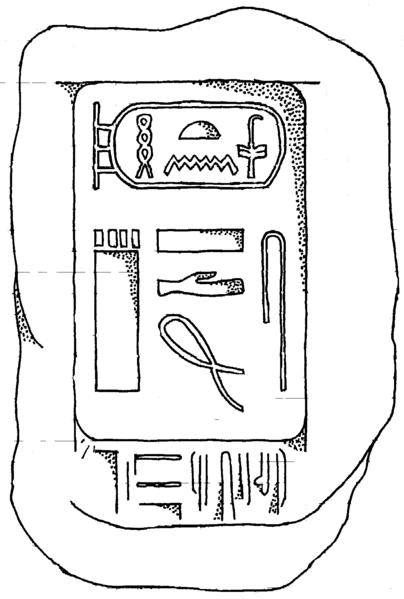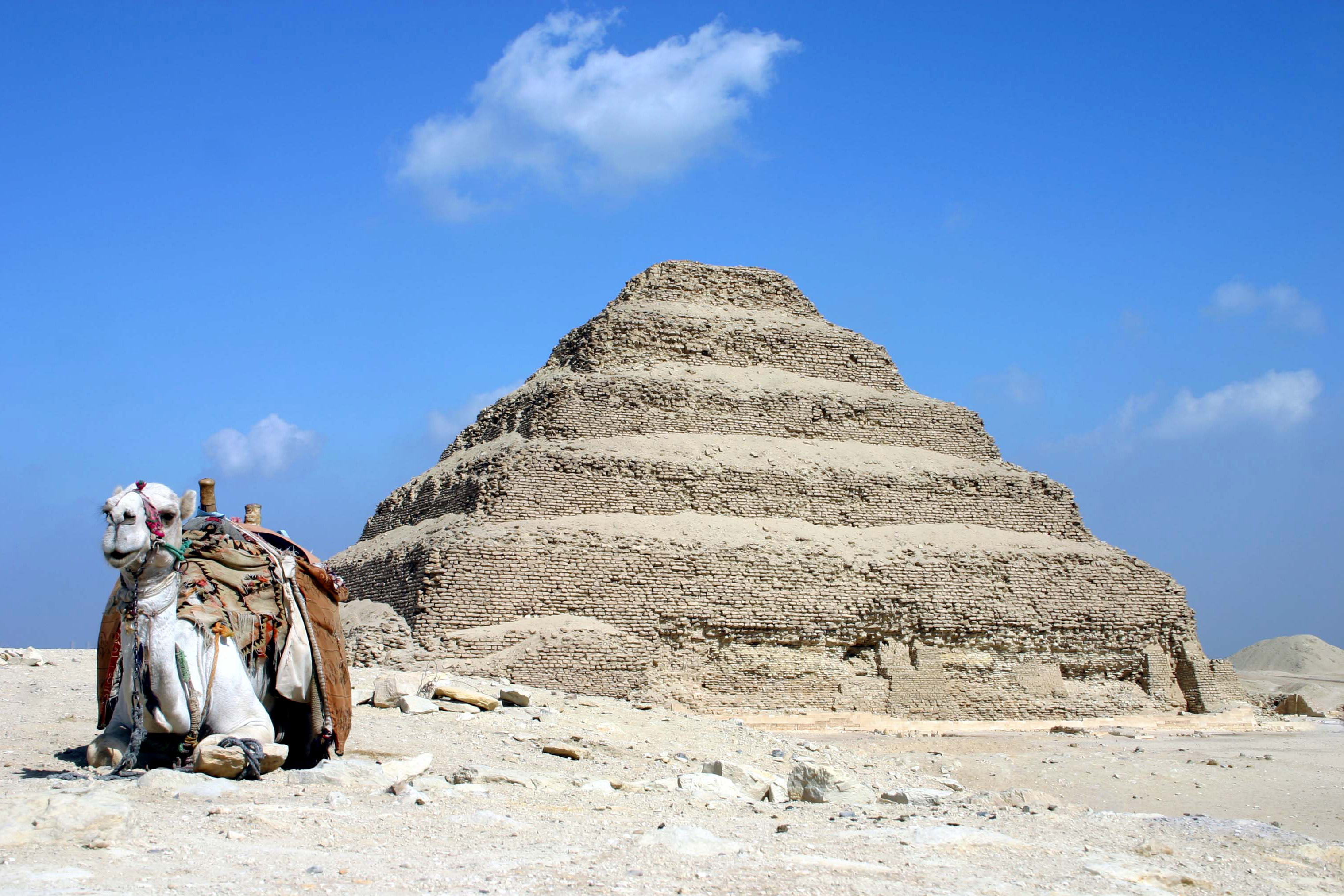|
Meidum
Meidum, Maydum or Maidum (, , ) is an archaeological site in Lower Egypt. It contains a large pyramid and several mudbrick mastabas. The pyramid was Egypt's first straight-sided one, but it partially collapsed in ancient times. The area is located around south of modern Cairo. Pyramid The pyramid at Meidum is thought to be just the second pyramid of four built by Sneferu after Djoser's and may have been originally built for Huni, the last pharaoh of the Third Dynasty, and continued by Sneferu. Because of its unusual appearance, the pyramid is called ''el-heram el-kaddaab'' (''false pyramid'') in Egyptian Arabic. The pyramid was erected in three phases, numbered E1, E2 and E3 by the archaeologist Borchardt. E1 was a step pyramid similar to the Djoser Pyramid. E2 was an extension around the previous building of roughly 5 m width or 10 cubits, raising the number of steps from 5 to 7. The second extension, E3, turned the original step pyramid design into a true pyramid by fill ... [...More Info...] [...Related Items...] OR: [Wikipedia] [Google] [Baidu] |
Sneferu
Sneferu or Soris (c. 2600 BC) was an ancient Egyptian monarch and the first pharaoh of the Fourth Dynasty of Egypt, during the earlier half of the Old Kingdom period (26th century BC). He introduced major innovations in the design and construction of pyramids, and at least three of his pyramids survive to this day. Estimates of his reign vary, with for instance ''The Oxford History of Ancient Egypt'' suggesting a reign from around 2613 to 2589 BC, a reign of 24 years, while Rolf Krauss suggests a 30-year reign, and Rainer Stadelmann a 48-year reign. Sneferu's name His name means "He has perfected me", from ''Ḥr-nb-mꜣꜥt-snfr-wj'' "Horus, Lord of Maat, has perfected me", and is sometimes read Snefru or Snofru. He is also known under his Hellenized name Soris ( by Manetho). Reign length The 24-year Turin Canon figure for Sneferu's reign is considered today to be an underestimate since this king's highest-known date is an inscription discovered at the Red Pyramid of Dahshu ... [...More Info...] [...Related Items...] OR: [Wikipedia] [Google] [Baidu] |
Huni
Huni (original reading unknown) was an ancient Egyptian king, the last pharaoh of the Third Dynasty of Egypt during the Old Kingdom period. Based on the Turin king list, he is commonly credited with a reign of 24 years, ending c. 2613 BC. Huni's chronological position as the last king of the third dynasty is fairly certain, but there is uncertainty about the succession order of rulers at the end of the third dynasty. It is also unclear under which Hellenized name the ancient historian Manetho listed him in his ''Aegyptiacae'': mostly likely Aches, as Winfried Barta proposes. Many Egyptologists believe that Huni was the father and direct predecessor of King Sneferu, but this is questioned by other scholars. Huni is seen by scholars as a confusing figure in Egyptian history, because he was long remembered in Egyptian traditions, but very few documents, objects or monuments from his reign have survived. Attestations Huni is not a well attested pharaoh; most of the ... [...More Info...] [...Related Items...] OR: [Wikipedia] [Google] [Baidu] |
Bent Pyramid
The Bent Pyramid is an ancient Egyptian pyramid located at the royal necropolis of Dahshur, approximately south of Cairo, built under the Old Kingdom King Sneferu. A unique example of early pyramid development in Ancient Egypt, Egypt, this was the second of four pyramids built by Sneferu. The Bent Pyramid rises from the desert at a 54-degree inclination, but the top section (above ) is built at the shallower angle of 43 degrees, lending the pyramid a visibly "bent" appearance. Overview Archaeologists now believe that the Bent Pyramid represents a change from the Step pyramid, step-sided pyramids of before to smooth-sided Pyramid, pyramids. It has been suggested that due to the steepness of the original angle of inclination the structure may have begun to show signs of instability during construction, forcing the builders to adopt a shallower angle to avert the structure's collapse. This theory appears to be born out by the fact that the adjacent Red Pyramid, built immediately ... [...More Info...] [...Related Items...] OR: [Wikipedia] [Google] [Baidu] |
Pyramid Of Djoser
The pyramid of Djoser, sometimes called the Step Pyramid of Djoser or Step Pyramid of Horus Netjerikhet, is an archaeological site in the Saqqara necropolis, Egypt, northwest of the ruins of Memphis.Bard, Kathryn A., and Jean-Philipee Lauer, eds. 1999. "Saqqara, pyramids of the 3rd Dynasty" ''Encyclopedia of the Archaeology of Ancient Egypt''. London: Routledge. 859 It is the first Egyptian pyramid to be built. The 6-tier, 4-sided structure is the earliest colossal stone building in Egypt. It was built in the 27th century BC during the Third Dynasty for the burial of Pharaoh Djoser. The pyramid is the central feature of a vast mortuary complex in an enormous courtyard surrounded by ceremonial structures and decoration. The pyramid went through several revisions and redevelopments of the original plan. The pyramid originally stood tall, with a base of and was clad in polished white limestone. As of 1997 the step pyramid (or proto-pyramid) was considered to be the earliest ... [...More Info...] [...Related Items...] OR: [Wikipedia] [Google] [Baidu] |
Third Dynasty Of Egypt
The Third Dynasty of ancient Egypt (Dynasty III) is the first dynasty of the Old Kingdom. Other dynasties of the Old Kingdom include the Fourth, Fifth and Sixth. The capital during the period of the Old Kingdom was at Memphis. Overview After the turbulent last years of the Second Dynasty, which might have included civil war, Egypt came under the rule of Djoser, marking the beginning of the Third Dynasty.Dodson, Hilton, ''The Complete Royal Families of Ancient Egypt'', 2004 Both the Turin King List and the Abydos King List record five kings,Toby A.H. Wilkinson, ''Early Dynastic Egypt'', Routledge, 2001 while the Saqqara Tablet only records four, and Manetho records nine,Aidan Dodson: ''The Layer Pyramid of Zawiyet el-Aryan: Its Layout and Context.'' In: ''Journal of the American Research Center in Egypt (JARCE)'', No. 37 (2000). American Research Center (Hg.), Eisenbrauns, Winona Lake/Bristol 2000, , pp. 81–90. many of whom did not exist or are simply the same king und ... [...More Info...] [...Related Items...] OR: [Wikipedia] [Google] [Baidu] |
Alan Rowe (archaeologist)
Alan Jenvey Rowe (29 October 1891 – 3 January 1968) was a British archaeologist most famous for his studies on ancient Egypt. Rowe was an Egyptologist and lecturer in Near Eastern Archaeology in Manchester University. Life Born in Deptford and raised in Essex, Rowe's work included Egypt, Cyrenaica, Australia, Palestine and Syria. Career Excavations Between 1923 and 1925 he took part in a core expedition to Giza. He worked from 1928 to 1931 on the pyramid of Meidum, and surrounding areas, during this time he discovered the first royal necropolis built in a style of a royal court. His work ended due to the Great Depression of 1931. In 1934 he led an expedition to Tel Gezer (midway between Jerusalem and Tel Aviv), but the locations identified for excavation turned out not to be workable. In 1938 he led a team from Liverpool University to the Pyramid of Athribis, unfortunately the structure was already in such a heavily damaged state, preventing more thorough examinations. Betw ... [...More Info...] [...Related Items...] OR: [Wikipedia] [Google] [Baidu] |
Step Pyramid
A step pyramid or stepped pyramid is an architectural structure that uses flat platforms, or steps, receding from the ground up, to achieve a completed shape similar to a geometric pyramid. Step pyramids – typically large and made of several layers of stone – are found in several cultures throughout history, in several locations throughout the world, with no known connections between the different civilizations that built them. These independent adoptions of a similar design presumably emerged at least partly because step pyramids have a lower center of mass than would a structure with straight vertical sides and are thus inherently more stable. Mesopotamia Ziggurats were huge religious monuments built in the ancient Mesopotamian valley and western Iranian plateau, having the form of a terraced step pyramid of successively receding stories or levels. There are 32 ziggurats known at, and near, Mesopotamia. Twenty-eight of them are in Iraq, and four of them are in Iran. Nota ... [...More Info...] [...Related Items...] OR: [Wikipedia] [Google] [Baidu] |
Mastaba
A mastaba ( , or ), also mastabah or mastabat) is a type of ancient Egyptian tomb in the form of a flat-roofed, rectangular structure with inward sloping sides, constructed out of mudbricks or limestone. These edifices marked the burial sites of many eminent Egyptians during Egypt's Early Dynastic Period and Old Kingdom. Non-royal use of mastabas continued for over a thousand years. The word ''mastaba'' comes from the Arabic word (maṣṭaba) "stone bench". The Ancient Egyptian name was pr- Djt, meaning "house of stability", " house of eternity", or "eternal house". History The afterlife was centralized in the religion of ancient Egyptians. Their architecture reflects this, most prominently by the enormous amounts of time and labor involved in building tombs. Ancient Egyptians believed that the needs from the world of the living would be continued in the afterlife; it was therefore necessary to build tombs that would fulfill them, and be sturdy enough to last for an eter ... [...More Info...] [...Related Items...] OR: [Wikipedia] [Google] [Baidu] |
Al-Maqrizi
Al-Maqrīzī (, full name Taqī al-Dīn Abū al-'Abbās Aḥmad ibn 'Alī ibn 'Abd al-Qādir ibn Muḥammad al-Maqrīzī, ; 1364–1442) was a medieval Egyptian historian and biographer during the Mamluk era, known for his interest in the Fatimid era, and the earlier periods of Egyptian history.Paul E. Walker, ''Exploring an Islamic Empire: Fatimid History and its Sources'' (London, I.B. Tauris, 2002), p. 164. The material for updating this article is taken from Walker's account of al-Maqrizi. He is recognized as the most influential historian of premodern Egypt. Life A direct student of Ibn Khaldun, al-Maqrīzī was born in Cairo to a family of Syrian origin that had recently relocated from Damascus. When he presents himself in his books he usually stops at the 10th forefather although he confessed to some of his close friends that he can trace his ancestry to al-Mu‘izz li-Dīn Allāh – first Fatimid caliph in Egypt and the founder of al-Qahirah – and even to Ali ibn ... [...More Info...] [...Related Items...] OR: [Wikipedia] [Google] [Baidu] |







